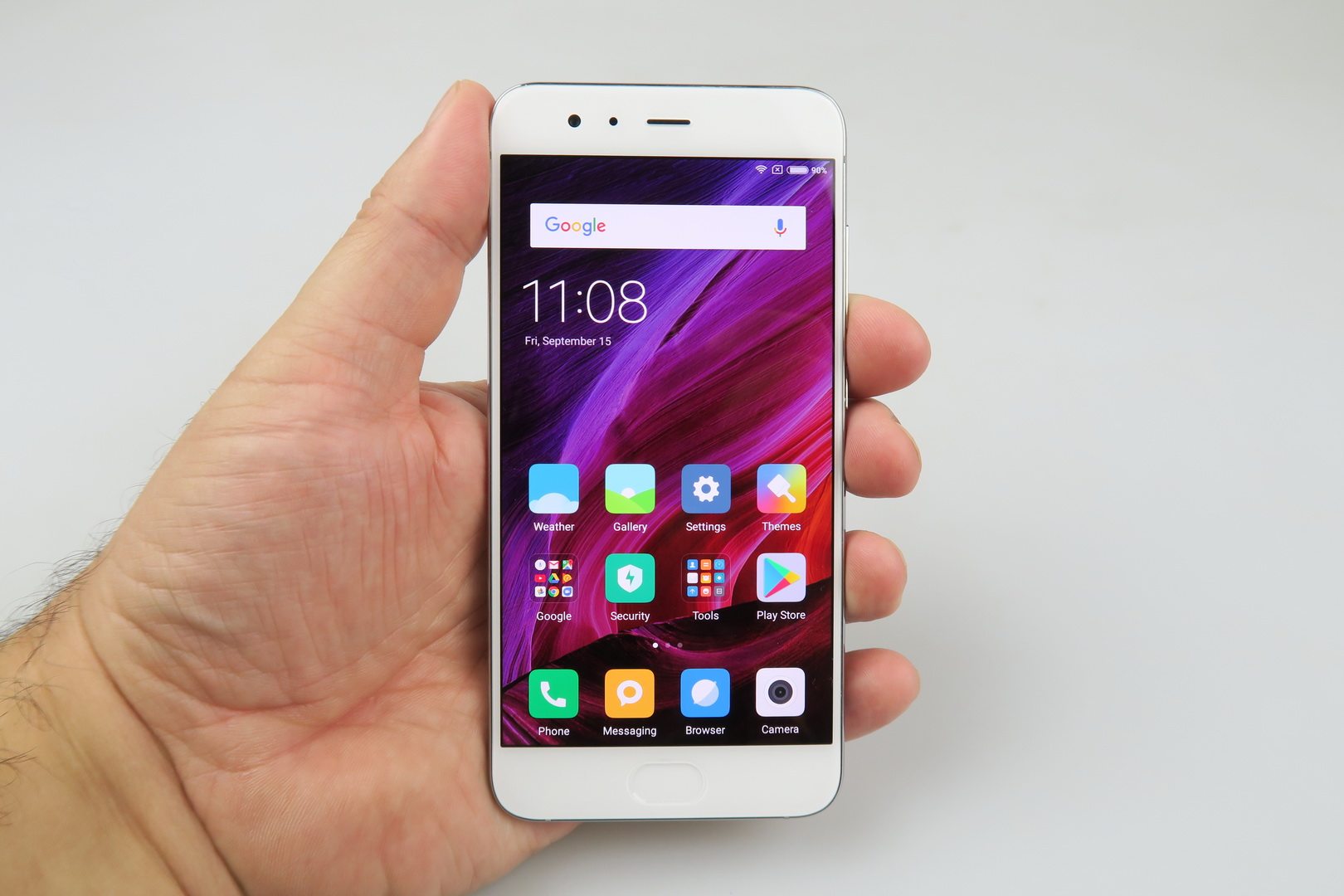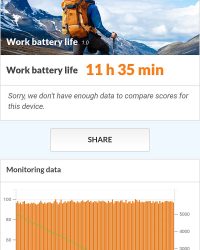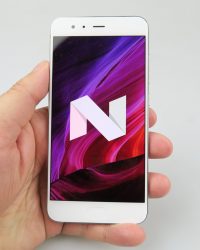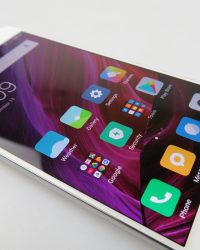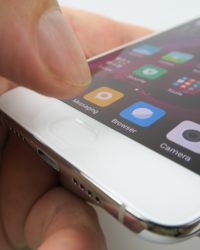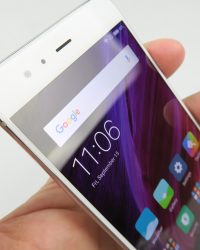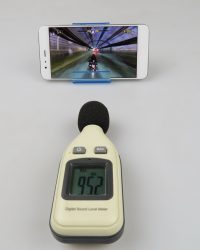After all the Xiaomi phones we’ve tested this year, I’ve certainly found the one thing they have in common: great battery. One of the most interesting ones was the Xiaomi Mi 6, that was actually one of the first Snapdragon 835 devices, if not the actual first on the market with that CPU. Launched in the Spring, this is one of the more compact flagships, with a 5.15 inch diagonal. It’s priced at $465 and we reviewed it below.

It comes with a bundled case and it’s made of glass and metal, with the usual curved glass back we’ve already gotten used to on Xiaomis since the Mi Note. Design-wise we get a stainless steel frame here, which is not something you see everyday. The phone is splash resistant and has a glass panel upfront and one at the back. The typical glass sandwich is here, albeit with a pretty strong metal frame.
It’s certainly stronger than the Mi 5, that got to the “Wall of shame” in the JerryRigEverything tests. Available in black, blue or white, this 5.15 incher also has a ceramic body version, for those of you looking for something more special. It measures 7.45 mm in thickness, weighs 168 grams and this is actually a 40 gram increase from the predecessor, which is quite a lot, but it was needed for the extra resilience.

At least it’s slimmer than the Galaxy S7 and also just 16 grams heavier. A good piece of news is that this smartphone is not slippery and it’s comfy when used with a single hand. Strangely, even though it’s made of premium materials, it feels like plastic to the touch. It’s well built for sure, comfy and premium, I can guarantee that. The screen bezels are not narrow, because Xiaomi left that task to the Mi Mix models.
In the end we still have a compact, solid and elegant flagship on our hands. Moving on to the display, we get a 5.15 inch IPS LCD panel here with reduced glare and Full HD resolution. It’s got a 1500:1 contrast ratio and on paper it promises 600 nits of brightness. It can also achieve 94.4% NTSC color gamut. I’m actually surprised there’s no Quad HD, but I guess I’ll live, particularly since the screen is so bright.

When it comes to the actual viewing experience, we got some pretty vivid colors, bright images, wide view angles and excellent contrast, even in full sunlight. The black edges of the image in the video playback were a bit of a bummer though. Pixels have an RGB Stripes arrangement and the luxmeter showed an excellent value of 609 LUX, which at the time of the test placed the phone on the fifth spot all time, among all the phones that do not have that special setup involving sun light contrast mechanisms.
The result achieved above is superior to the one of the Galaxy S7 Edge and iPhone 6S Plus, but scores below the Xperia XZ and OnePlus 3. Display Settings include brightness, Reading Mode (reduces blue light with a slider included), Colors (Warm, Standard, Cool) and Contrast. The latter mode lets you use Automatic Contrast, Increased Contrast or a Standard mode.

There’s also text size to tweak and double tap to wake. All in all a pretty solid experience. Moving on to the hardware, we’ve got the powerful Qualcomm Snapdragon 835 chipset here, a 10 nm chip with a 2.45 GHz clock rate and the Adreno 540 GPU in tow. There’s also 6 GB of RAM in the mix, of the LPDDR4X variety and 64 bit dual channel one even.
Xiaomi Mi 6 comes in 64 GB and 128 GB storage versions, but it has no microSD card slot. On the performance front there are only good news, as there’s no lag and apps start up fast. You can queue as many as you want and still there’s no problem. Riptide GP Renegade looks great and so do all the others games we ran. We also did a bunch of benchmarks, like Quadrant, in which we surpassed the Galaxy S6 and Huawei Mate 9 Pro, but scored below the Huawei Nova and LG G5.

In AnTuTu 6 we actually fared quite OK, with a second place in the all time ranking, beating the HTC U11 and Galaxy Note 8, but scoring below the iPhone 7 Plus. In GeekBench 4 we also scored high, with the single core sub test placing us above the Galaxy S8+ and HTC U11 and below the iPhone 7 still. The multi core one had us above the HTC U11 and iPhone 7 Plus, but below the Galaxy S8 and Note 8.
We also did temperature tests, achieving 34.6 degrees Celsius in GFXBench and 35.5 degrees after Riptide GP Renegade, so there’s no overheating here. On the battery front we’ve got a 3350 mAh unit, of the Li-Po variety and it comes with support for Quick Charge 3.0 at 18W. Leaving that aside, this phone has big shoes to fill, since the Mi 5 before it had a fantastic battery.

In our HD video playback test we achieved 13 hours and 4 minutes of playback on the Mi 6, making for quite a solid showing of a Netflix season, maybe Stranger Things 2. This surpasses the Moto Z2 Play and iPhone 7, but scores below the Huawei P10 and Huawei Mate 9. In PCMark we scored 11 hours and 35 minutes, which is excellent and places the device on the 10th place all time.
It surpasses the Allview P8 Energy Pro and Huawei Mate 9, plus quite a few battery phones. Still there are other record breakers, including a Xiaomi one, the Redmi 4. Charging was amazing, at just 1 hour and 27 minutes and frankly I didn’t see this coming. It beats a ton of other phones, basically all 2017 flagships. Step by step charging is also fast, with an 11% charge achieved in 5 minutes and a 27% one in 15 minutes.

30 minutes means 54% and 1 hour is 91%. How crazy is that? The Settings include a Battery Saver option, with an Analyze feature, App Battery Use, Sleep Saving Modes and System Animations you can hide or show. A fantastic battery overall, possibly the best on a Chinese flagship ever. Let’s talk acoustics now!
There are stereo speakers here, something that not even Samsung could achieve on the Galaxy S8 and Note 8. There’s the earpiece and the bottom speaker, working together, while the preinstalled music player offers a Sleep Timer, an EQ for headphones, options for the type of buds and Mi Sound Enhancer. The actual listening experience was loud and clear, with a small vibration of the back side, the bass was pounding and the highs and voice were quite nice for my ears.

There are no headphones bundled here and no FM radio. We used a decibelmeter to measure the performance and achieved 95.2 dBA when running Riptide GP Renegade, which is better than the Samsung Galaxy S8 or Huawei P10 Lite, but below the Huawei P10 and Bluboo S8. The other result we achieved with our typical audio sample is 84.9 dBA, which is OK, beating the Xperia XZ1 for example.
I couldn’t resist it and I hooked up my EarPods to the audio jack, playing with the EQ’s 7 custom channels and I loved the bass. Now let’s talk camera! We get a dual back camera here, with a 12 MP + 12 MP setup and the first cam is a 1.25 micron pixel affair, with 4 axis OIS, 6 piece lens and F/1.8 aperture. There’s also a two tone flash and this is a Sony IMX 386 sensor I’m talking about.

The second camera of the dual setup uses a telephoto lens, has 1 micron pixels and F/2.6 aperture, as well as 56 mm focal length. There’s 2X optical zoom for the whole shabang, PDAF and HDR, while selfies are taken with an 8 MP shooter with 36 Beauty profiles. The camera app is rather simple and includes the Portrait (Bokeh) model, HHT which is Night, Audio, Beautify, Square, Timer Straighten, Tilt Shift Panorama, Manual and Group Selfie.
There’s also ISO, exposure, focus and white balance tweaks, plus a shutter option. HDR, 4K video, contrast, saturation and sharpness can all be set up. I’d say this cam has a fast focus, reasonably speedy picture taking and a fluid zoom. When it comes to the actual picture taking, we have a full gallery of day time shots to show off. First things first, I couldn’t figure out how to use the Portrait Mode, at an ideal distance.

Even when it worked it felt gimmicky and forced, unlike the Huawei P10 or iPhone 7 Plus. Bokeh is overrated anyway. We took pics on a cloudy and windy day, but caught some great details, realistic colors and just like the Mi 5, the selfies were AMAZING. It clearly beats any Galaxy S8 or Note 8 you can imagine and the Xperia XZ1 is the only contender. Some Beautification is applied, but even without it I’m sold.

Macros are solid, pics are pragmatic in general, in exposure, color and brightness. This is not a flawless camera, as every once in a while there was the odd blurred shot, that shouldn’t quite happen on a flagship, right? There’s great focus and texture, a well rendered sky and the zoom in leaves you with a ton of details. HDR highlights the details of that bell and sculptures and I actually used this phone during an iPhone 8 launch event, as a DSLR replacement.

It didn’t fair quite perfectly, as the closeups got a bit blurred indoors, but with a bit of patience I made it work. 2X zoom does to the job it promises, with no detail loss. In the end the simple fact we have 2% of the hundreds of pics failed tells us this is not like the other flagships. You could take 1000 pictures with the Galaxy Note 8 and maybe 3 or 5 would be failed. Xiaomi is far from that ratio.
At least we surpassed the Mi 5 and no longer have weird green hues and burnt areas. This is very much like the Huawei P10 or P10 Plus in performance and slightly below the LG G6. It feels a bit like an upper midrange rather than a flagship, something like Vivo would make let’s say. Let’s move to the low light capture. First of all the flash makes things too white and brightness was OK at first. The zoom was rather poor, dropping details like the game DOOM drops bullets.

Overall things are quite dark compared to other modern handsets, but at least they’re not very yellow. We did spot some pink hues here and there, which are a bit annoying on a flagship. We’ve got great light halos here, with finally the proper size of street light halos. We also caught on camera some very nice flowers, with excellent color hues.
Again, the pink annoys me, but it’s a tradeoff for not getting the annoying yellow hue. I’d put low light photos on par with the ASUS ZenFone 3 and Huawei P10, but far from the Galaxy S8 and Google Pixel XL. Let’s see if the video is any better. We filmed in Full HD, MP4 format, at 30 FPS and 20 Mbps bitrate. Focus was spot on and fast, plus the color was well calibrated. The microphone is good, catches voices and ambiance perfectly.
Things are a bit shaky and curvy when walking around. I loved the decent exposure change, which was also subtle. Zoom is rather poor, with details lost at the first sign of pinching the screen. The capture is also a bit dark, but the clarity is OK. There’s no problem with panning or moving cars. In the distance things get blurred and don’t appear to be very clear.
I also tested the stabilization, which was rather OK, because there was no refocusing and clarity was excellent. The microphone is a bit too easy to cover, making things sound really echoey. Sadly, this is by no means the behaviour of a flagship, but rather of a high profile midranger, like the Galaxy A5 (2017), maybe a bit better. It’s 10% above the Xiaomi Mi 5, but below the clarity of the Xperias.
I was not impressed overall. In low light conditions, filming featured some strange lines, but the clarity was quite decent. Things were dark again, the zoom was so-so at best and once again street light halos had a decent size. Some annoying things to mention; wavy images, pink hues after zooming in, but overall not very bad, compared to other vulnerable yellowish night filming handsets out there. It’s no HTC U11 or Galaxy S8 and only slightly above the average midranger performance.
Let’s talk browser now. The preinstalled browser is quite fast and the Chrome benchmarks were fantastic (Vellamo and Sunspider). The virtual keyboard is comfy and includes Swype, which is as usual a comfy input method.

Connectivity is up next! Xiaomi Mi 6 has an USB Type-C port at the bottom, but ditches the audio jack. It’s got a dual SIM setup, WiFi a/b/g/n dual band and 2×2 AC MU-MIMO. There’s also WiFi Display, WiFi Direct, Bluetooth 5.0, NFC, plus infrared, used to control TV sets, air conditioners, set top boxes and more. There’s also 4G LTE Category 16, GPS, Glonass, Beidou and on paper we are promised up to 1 Gbps cellular speeds. WiFi on paper reaches 867 Mbps in download.
And the list goes on: Miracast, DLNA and Google Cast. Calls were loud and clear and SpeedTest results were at 65 Mbps in 4G download and 65 Mbps in upload too. When it comes to WiFi, we reached 194 Mbps in download and 26 Mbps in upload. Good results overall and the future of 1 Gbps sounds great. Now let’s have a look at the software. We’re dealing with MIUI 8, on top of Android Nougat and it’s a minimalistic UI, as far as the icons and vibe are concerned.

Multitasking still happens in old school style, with horizontally scrolling thumbnails. Pinching the homescreen brings up themes, widgets (same for years), wallpaper and effects. The dropdown bit includes an elegant area of Quick Settings, plus notifications. Settings include a Pocket Mode and the options for the fingerprint scanner. There’s a 12 step setup and the scanner is accurate and fast.

There are status bar options and there’s also a Second Space feature, that feels like you’re using two devices in one, with a whole new user account. Among the Settings we found the Do Not Disturb mode, a floating widget called “Ball”, One Hand Mode, plus there’s dual apps and app lock. There’s no app drawer here and as far as the apps go, there are 37 preinstalled pieces of software here.
That’s rather OK, so no bloatware. Stuff is pretty basic, with Security (Cleaner, scan etc), Recorder, Notes, WPS Office, SwiftKey, Mi Remote and more. Basic package, but I feel that MIUI needs a total revamp, because it’s kind of old and antiquated right now. It hasn’t changed in about 3-4 years. I guess now it’s time for the verdict!

Here are the Pros:
- great selfies
- high performance
- OK build
- bright screen
- great battery
- fast charging
- OK volume
- stereo speakers
- good details in pictures
- fast connectivity
- minimal UI
And the Cons:
- looks a bit like plastic, at least the version we had
- glossy frame
- small screen, only Full HD
- too few camera options
- Portrait option is not convincing
- video capture should be better
- MIUI multitasking feels old
This has got to be the highest performing sub 5.5 inch smartphone of the first half of the year. It’s got a midrange level camera, although I feel that Xiaomi was going for a flagship one. At least they got the selfies right, since they look fantastic. Audio is good, the screen is very bright so only good things, except for the UI and parts of the camera.
And even the camera has its qualities, like the color hues, clarity and such, but the video and zoom ability are far from impressive. In the end people will buy it for a compact package good enough for a long session of gaming, thanks to the fantastic battery and CPU pairing.
Here are some retailers where you can find the device:
Gearbest
Geekbuying
BangGood
TomTop

